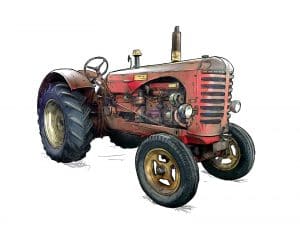Antique Engines: The History of the Tractor

The First Tractor
The physical labor required to remove weeds and harvest crops was substantial in the early days. Early on, corn was one of the last crops that required physical labor during harvest time. One of the earliest methods for clearing land involved the draught horse. These working horses pulled heavy loads and other farm equipment to perform weeding and harvesting functions. The earliest mechanical tractors were developed using portable engines, or steam engines, that were able to move farm equipment. During the mid-19th century, inventors improved engines and created the traction engine. The traction engine, which was powered by steam, was adjusted to meet the needs of farmers. The engines were able to pull heavy loads. John Carter invented one of the first tractors in Illinois during the late 19th century. This early device caught on slowly, but laid the groundwork for future tractors.
Tractors and the Agricultural Industry
The introduction of the mechanical tractor changed the agricultural landscape. The number of horses and mules used to perform farm work was roughly 25 million in the United States during the early 20th century. Farm workers needed to provide food, shelter and veterinary care for each of their animals, which could require a substantial amount of financial resources. The introduction of the tractor reduced the costs associated with maintaining animal labor. Farmers could spend less time and money planting hectares of land to support animal feed crops. In addition, the tractor could perform a range of important tasks, including turning the soil and pulling substantial loads. The tractor’s introduction also had some adverse effects on the farming industry. For example, farm sizes underwent an increase after the tractor became available. Many farmers could no longer maintain smaller farms and sought work elsewhere. Consequently, the government sought to provide financial support for smaller farms through the Agricultural Adjustment Act.
- Beyond Tractors: The History of Technology in Agriculture (PDF)
- Agricultural Mechanization
- Tracing Crop Rotations Through Time: A Search for Sustainability
Tractor Engines
Some of the earliest tractor included the steam engine. The steam engine creates mechanical work using heat and steam. Early inventors designed the traction engine, which uses steam, specifically for pulling heavy loads. Over the years, engines evolved and steam engine technology saw a sharp decline. Internal combustion engines were used to replace steam-powered tractors. The combustion engine uses fuel, such as gasoline, to create mechanical power. Diesel fuels began to gain popularity during the mid-19th century and today, many modern tractors use this type of fuel.
- Brief History of the Steam Engine
- The Corliss Steam Engine of 1876
- The Growth of the Steam-Engine (PDF)
- Steam Engine, Alexandria, 100 CE
- Thomas Newcomen’s Steam Engine
- Electric Tractors
- The National Traction Engine Trust
Antique Tractors
From Farmall to John Deere, there exists a wide range of antique or collectible tractors. For example, the Mogul 8-16—a tractor produced in 1939 by the International Harvester Co.—is considered an antique tractor designed to manage smaller areas. Farmall produced the IH 8-16 Kerosene during the early 20th century. John Deere’s Model A tractor is considered one of the most famous and popular early tractors and was produced in 1934.
- History of International Harvester
- Foothills Antique Tractor and Engine Club: Featured Equipment
- Fageol
- Steam Plowing History
Learn More about Tractors and Their History
People interested in learning more about tractors and their history can consult a range of resources. Multiple museums that pay homage to the tractor, its contribution to agriculture and antique models exist. In addition, many counties across the country host annual fairs that place antique and modern tractors on display for people to see. Many cities host antique tractor and pull shows. Many colleges and universities offer an extension program that focuses on the development of agricultural practices. State colleges might offer additional information on locating resources to research tractors.
- Tractors, Combines and Science
- Farming in the 1930s
- Safety with Farm Tractors
- The Farm Debut of the Gasoline Engine
- The Tractor Changes Rural Life
- Historical Sketch of Tractor Testing
- Getting in the Tractor Seat, Some for the First Time
- Technology as Masculinity: Antique Tractor Collectors and the Identities Embedded in the Machines
- A Concise History of the Traction Engine
- From Waterloo to the World
- Farming as it Was
Written by: Milan Alcot



